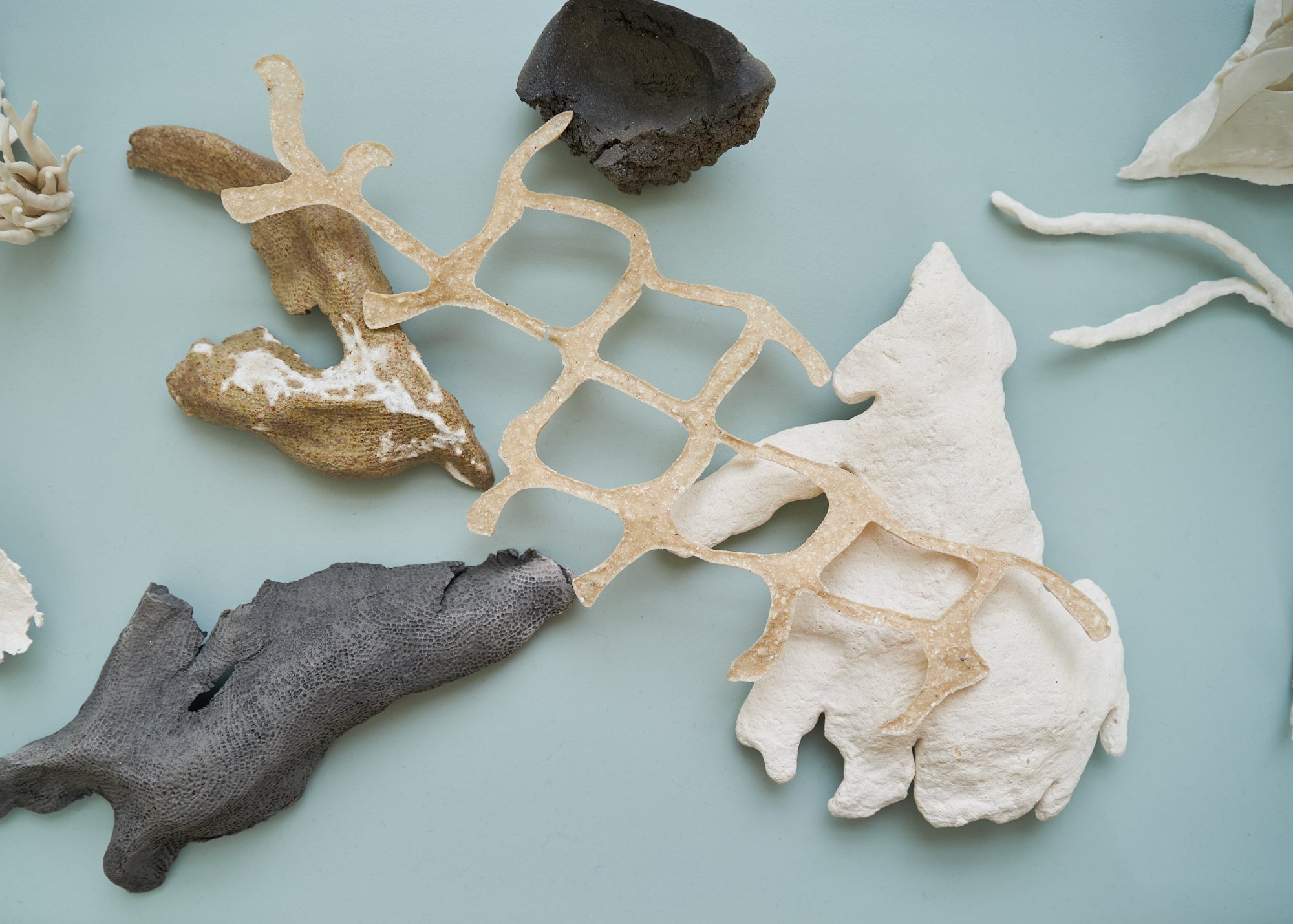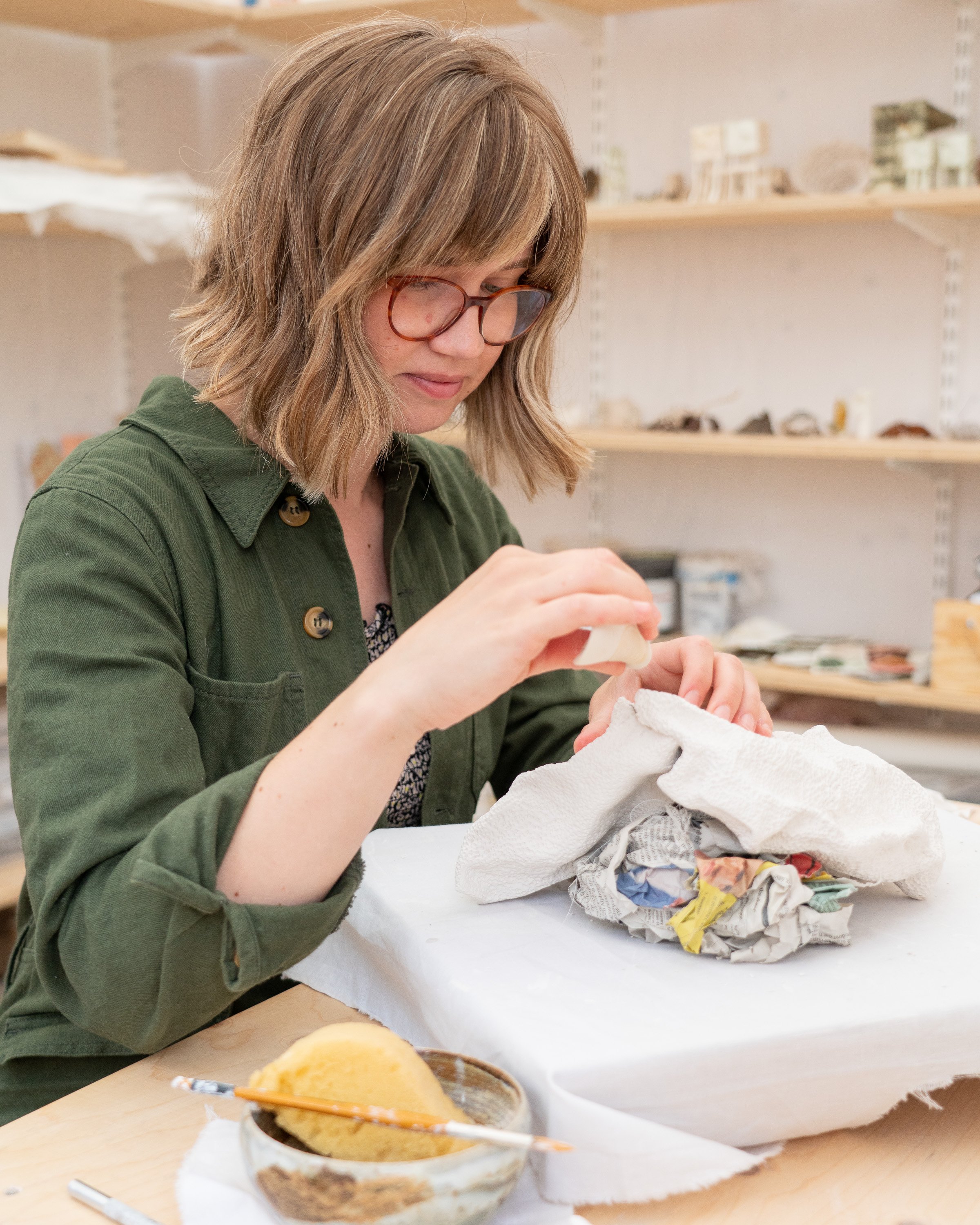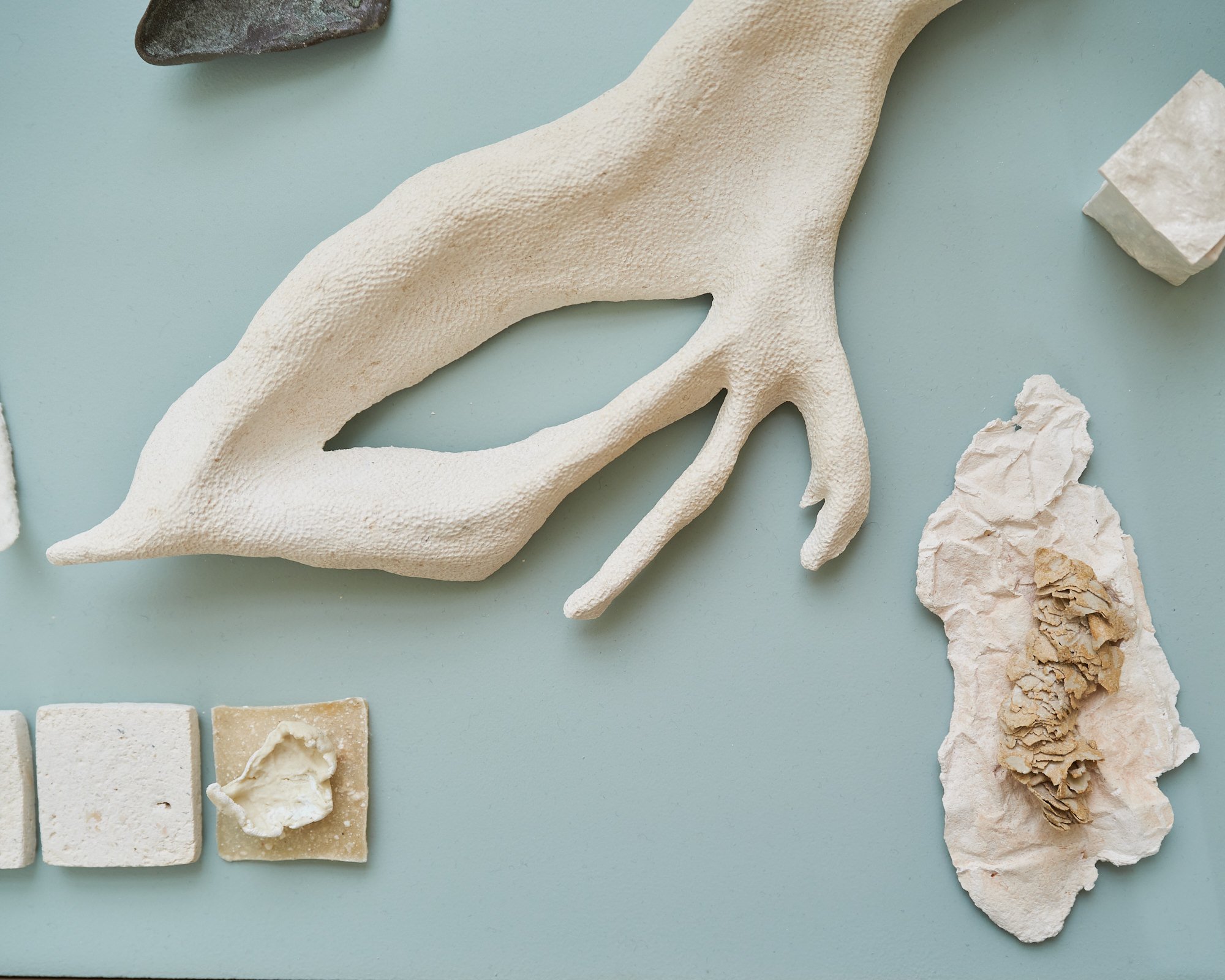Louise Frances Smith
Collect install Assemblage no1 oyster shells, 2023 (detail)
mixed media including clay and crushed oyster shells
photograph by Yeshen Venema
interview by Lara Monro
In the context of art history, sustainable ways of creating have been around since the birth of conceptual art in the 1960s. Take German artist, Nils-Udo, whose plant creations placed in nature were left to develop and subsequently disappear as a way of commenting on the links between nature and humanity. Today, as we are faced with the sobering realities of humankind’s impact on the planet, environmentally-conscious art forms are becoming increasingly widespread. By working with found objects, natural and upcycled materials, and through processes that intentionally avoid damage to the Earth’s resources, artists are using their creative expression to highlight environmental degradation and the stark reality of climate change.
Margate-based artist Louise Frances Smith worked mainly with clay until she became increasingly concerned and frustrated with the unsustainable plastic packaging used to store her medium of choice. After conducting considerable research, it became clear to her that it was not possible to naturally source clay from her local area, so she decided to get creative and utilize what was available, better yet, she used what was in abundance: seaweed and oyster shells. Smith has spent the last two years collecting and experimenting with both as part of her newly adopted approach to creating sustainable work.
This year, as part of Somerset House’s 2023 Collect, Smith exhibited Sargassum Tide, a new body of work that examines wireweed seaweed and Pacific oysters, two non-native species thriving on the UK coastlines due to climate change. She subsequently presented the series in a solo show at The Margate School where she facilitated workshops on how to work with sustainable materials in collaboration with community groups, families, and creative practitioners.
In the following interview, Smith shares her journey with adopting a sustainable art practice, discusses the scientists, artists, and experts that have inspired her, and where she hopes to take her sustainable practice in the future.
LARA MONRO: You began your creative practice working with clay to create sculptural works. What initially drew you to this medium?
LOUISE FRANCES SMITH: My first encounter with clay was on my degree at Kingston University. It was a Fine Art degree so I took advantage of being able to play with different materials—I worked for a while with latex, paper pulp, drawing, and printing. Then in my third year, one of our visiting lecturers ran a clay workshop. After my initial frustration with this new medium, I quickly fell in love with it because you can do so much; I love its tactile qualities. There is so much scope when working with clay and the different stages of making—dipping in slip, adding glaze, creating textures, casting, carving, moulding, slab building, coiling, there are so many possibilities. I enjoy being able to combine clay with other materials too and I’m keen to continue exploring this in my work.
Studio portrait of Louise Frances Smith
photograph by Stuart Leech
MONRO: In recent years you have introduced sustainable, bio and found materials into your practice. Can you tell me about this development—what was the catalyst for the step change?
SMITH: Covid and the 2020 lockdowns, a catalyst for so many things. My place of work was closed and I was very lucky that my daily walks allowed me to explore 15 - 20 minutes down the road to the Margate coastline. I’ve always been drawn to my surrounding landscapes and my work has been influenced by the coastline, but this was a deeper connection because it became a part of my daily routine. I made a body of work called Fragments of Isolation, Margate where I was starting to look closely at the patterns of the landscape, both natural and man-made, and making collages from photographs and drawings of my walks. When I started to translate these drawings into clay there was a disconnect when I was pulling clay out of a plastic bag. I knew this material (clay) came from the ground, but I didn’t know how to go about looking for it. After being successful in applying for Arts Council England ‘DYCP’ funding, I learned how to dig my own clay via two incredible tutors over zoom, Rosanna Martin and Nina Salsotto Cassina (Unurgent Argilla). I soon discovered there is no clay in Margate, so I started to look at what materials there were along the coastline and seaweed was one which is in abundance—this led to research into biomaterials. I was very inspired by a Material Matters podcast with Julia Lohmann, from The Department of Seaweed, who I was also lucky to have a mentorship session with. There are a lot of incredible artists and designers working sustainably who have inspired me to continue this journey in my own practice.
MONRO: What is your process for sourcing your found objects/materials?
SMITH: I take a bag with me on my daily walks and pick up anything from the beach that I find intriguing—like a strange piece of rock or a beautiful shell. I also try to collect any litter I see when I’m doing this too; there are always fishing nets tangled in with seaweed. I don’t use any of this in my work at the moment, it's mainly the natural objects I use. I only collect seaweed that’s washed up on the beach, most found on Margate beaches can be collected from April to September (to allow nesting birds to take the seaweed over winter) but the seaweed I have recently been working with is an aggressive, invasive species (wireweed), so I have been allowed to collect that over winter months too. I make sure to shake it out before bagging it so I’m not taking any little critters home!
I have also been collecting oyster shells from a local restaurant in Margate, Angela’s. They do not have a use for the shells after the oysters have been eaten so I go and collect them as a waste material to use.
MONRO: How do you incorporate these into your work—do they define how you create a new piece, or inform it?
SMITH: I think it varies from material to material and what the idea of the work is in my head! I’ve recently learned about Material Driven Design through a brilliant bioplastics course run by Through Objects and Bonnie Hvillum (Natural Materials Studio). It was an interesting concept for me because I think sometimes I have an idea of what I want to make in my head (from my sketchbooks, research) and I’m looking for a way to do so. When you work with clay, you can get it to do so much, in a myriad of ways. Whereas when you work with a new material, it’s fun to experiment and play with what it can do and then bend your idea or concept to adapt with the material’s qualities.
There have been a lot of experiments that I haven’t been able to use. But then, I started to look at these fragments from my experiments and use this ‘waste material’ to make collage. I’m trying to keep a circular practice and consciously ensure there is no waste. So, to answer your question, it is both.
MONRO: Since adopting a sustainable creative practice what have been the most insightful lessons you have learned from being more environmentally conscious?
SMITH: When I started looking at making my practice more sustainable, I was thinking about the materials I was using and how I was sourcing them, which is really important. But something I hadn’t thought much about was waste from my studio and making processes. There were techniques I was already using that I hadn't thought about but are very important: recycling clay and glazes, finding ways of using firing pieces to reuse in the work in some way. There are so many potters and clay studios who adopt these practices already but might not on the surface appear to have a ‘sustainable practice.’ Waste is the first thing to look at, and also if you can use someone else’s waste, then even better! There is a brilliant book called Wasted by Katie Treggiden that highlights a lot of artists using waste as a material in so many different ways and across different industries. Katie also says that it’s important to stay curious and that it’s okay to be imperfect, and I think that’s really great advice. No one is going to have a totally sustainable practice over night, so it’s all about making small changes and building on that. I am still on my journey, I know I will continue to make mistakes and that there is so much I can improve on. I’m excited to see where my line of enquiry takes me as I continue to embrace these changes.
MONRO: You recently exhibited Sargassum Tide, a new body of work at Collect 2023. Can you tell me about the series?
SMITH: The works in Sargassum Tide are made using wireweed seaweed (Sargassum muticum) and Pacific oysters (Magallana gigas). These are two non-native species currently thriving on the UK coastlines due to climate change. I wanted to make work that shows the repercussions of human intervention on our fragile coastal ecosystems through the materials. The inspiration for the works comes from epibiosis; the close interaction between two different organisms, the host organism providing an environment for the other which is attached to its living surface.
Pacific oysters were introduced to the UK for farming in the 1970s. They brought with them wireweed seaweed which was thought to have been attached to the oyster shells. At the time it was believed that it would not flourish, but since the rise in sea temperature, these species can now bloom. My research has led me to conflicting evidence of whether these species are ‘good’ or ‘bad,’ which has been really interesting. I think what drew me to these materials initially, beyond the story of their arrival, was that they are currently in abundance on my local coastline and can be used.
MONRO: In April you exhibited Sargassum Tide at The Margate School. Was it important for you to showcase the work within the local environment from which most of the inspiration and materials came?
SMITH: Yes, very important. I was really excited about displaying the works at Collect 23, in such a beautiful ornate building, and to a new audience. But an important part of the project is to highlight the abundance of these materials locally. So it felt important to share what I had collected from the landscape with the local community in Margate. I would love to inspire others to use these materials that are in abundance on our local coastlines, or just to be aware of what is there—to look closer at our local environments.
Louise Frances Smith
Collect install Assemblage no1 oyster shells, 2023 (detail)
mixed media including clay and crushed oyster shells
photograph by Yeshen_Venema
MONRO: You facilliated workshops on how to create sustainable art works using biomaterials as part of the exhibition at The Margate School with local community groups. Are you keen to pursue this educational element as part of your practice?
SMITH: The workshops I conducted were a combination of making works with biomaterials and also clay workshops where we explored texture, pattern, and shapes from the local coastline. Working with biomaterials requires a bit of extra health and safety precautions so it hasn’t been possible to run these for all of my workshops, but just starting to have these conversations with people and showing them what you can do with biomaterials is really important. I’m really keen to pursue this as part of my artistic practice, and to learn more about what local community groups would like to understand about how to create sustainable work.
I am also working with a creative digital agency, Studio T, to create a new section of my website that I will update quarterly with interesting content for artists and makers on their journey to having a sustainable practice. So, there will be a recipe for something to make, an interview with another artist, and a short film about a material or process I use in my work. This has all been made possible by an Arts Council England National Lottery Project Grant I received at the end of last year.
MONRO: Are there any materials you are interested in experimenting with moving forward? Perhaps there are places in the UK you would like to explore to take inspiration for new work?
SMITH: There are so many possibilities and so many materials to explore! I feel like I’ve just scratched the surface of working with biomaterials. I think next, I would love to collaborate with other artists and biodesigners. I am very interested in the texture of the oyster shell pieces so I would like to continue on this and explore how far I can push the material in terms of scale. I still have a passion for clay. There are so many places over the UK where you can dig and process your own, so I would like to continue with this research in the future too.





